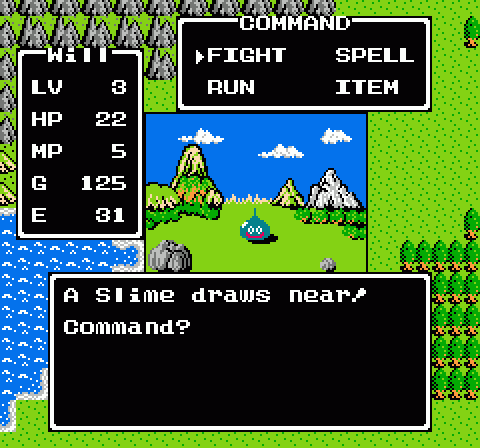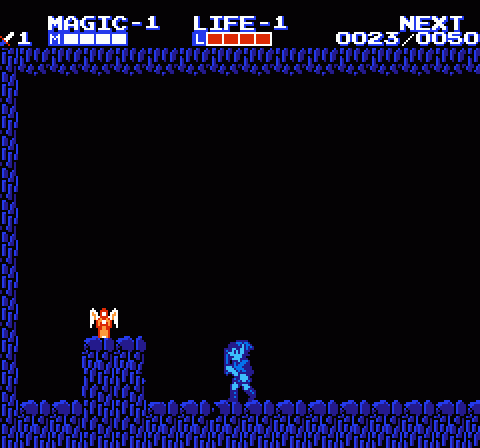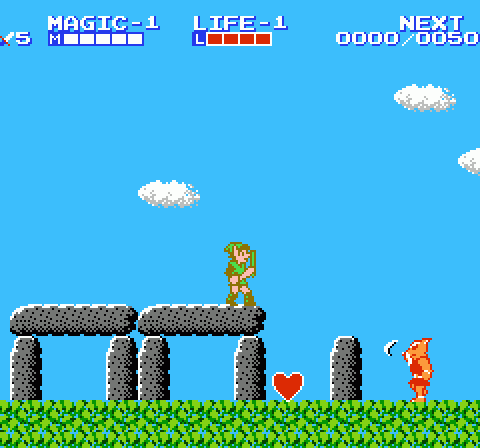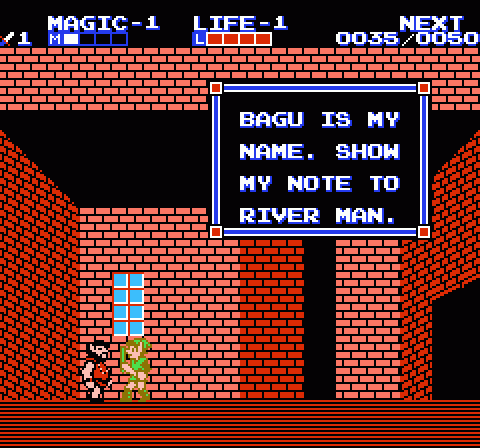I forgot to mention it before, but in this series (as in all these Anatomy articles) the overwhelming majority of images you see here have been provided courtesy of VGMuseum.com. Because Rey is rad.
The more I play of Zelda II, the more I’m struck by the realization that Nintendo must have been heavily influenced by Dragon Quest as they were building this game. The original Dragon Quest launched in Japan about 10 months before The Adventure of Link, and given the short turnaround period for many games back then (six months was considered a luxuriously long development cycle) there was plenty of time for it to have seeped into the minds of Shigeru Miyamoto et al. Of course, Dragon Quest didn’t become the Japan-crushing super-sensation we know it as today until well after launch, but I have trouble believing that Nintendo’s internal teams weren’t aware of games coming through the company’s approval systems — and I have even more trouble believing that such skilled designers wouldn’t recognize a brilliant game when they saw one.
But no, maybe it’s a coincidence that Gels went from being featureless teardrops in The Legend of Zelda to little balls of slime with eyes. And that the first Zelda‘s visual indicator of displaying enemies’ relative strength through the color palette somehow reversed so that red Gels are now stronger than blue — exactly as in Dragon Quest. No, seriously, it could be a strange coincidence.

Nevertheless, Zelda II truly does fit the bill of the “action RPG” nomenclature attached to it. Despite its more arcade-like combat style, its overall structure falls very much into the template of the classic role-playing game. And I do mean classic: That is, non-linear, open-world, free-roaming. Like Dragon Quest and Ultima before it, Link can largely travel anywhere he likes provided he has the proper tools for the task. Environmental impediments create barriers to progress, and once you move beyond a “gate” to the next region the enemies you encounter grow more powerful. Most of the dungeons have to be tackled in sequence, but again, you don’t have to finish any of the dungeons until the very end of the game (as in the original Zelda, the final palace is sealed away behind a barrier that can only be dissolved by completing the in-dungeon objectives). You instead unlock forward progress by finding tools in dungeons, magic spells, or completing tasks for NPCs.
Case in point: Once you clear Parapa Palace, you don’t simply advance to the next area. You’ll remain trapped in the initial region even when you possess the candle that lights the cave leading to the lands beyond, because at the end of that cave waits a high wall that cannot be climbed or leapt. In order to pass, you need to acquire the spell Jump to allow you to leap to greater heights. But in order to do that, you’ll first need to retrieve the “trophy” that a Goriya stole from the town of Rauru so the local Wise Man will teach you the spell. For that, you need the candle…

…unless you’re crazy enough to sequence-break and get the “trophy” in the dark.
I put quotes around “trophy” because the idea that some kind of tournament prize is of vital importance to an entire town is… well, I grew up in Texas, where the identity of entire towns did revolve around winning football championships. But I’d like to believe that Hyrule is more sane. No, clearly, the “trophy” is actually a religious icon or goddess figure or something and this was one of those situations where Nintendo’s pathological fear of riling up red-blooded Midwesterners by daring to suggest that religion exists in the world (and doesn’t necessarily involve televangelists in all cases) resulted in a a very ridiculous alteration.
While Zelda II has many quirks and flaws that define it very much as a product of its era, its checkpointed-yet-organic approach to progress feels very timeless. (I suppose the cynic might claim it’s an equally dated style of play, since so many contemporary games lay down a more rigid path and carefully point out where you need to go next.) Link’s adventure lets you wander about until you piece the clues together or simply stumble into the answers — either approach is valid — and while it occasionally breaks down and becomes frustrating, that happens much further into the game when the player is juggling more possibilities in a larger amount of space.
Here, though, it works brilliantly; you’re given a finite territory to explore and left to discover the proper sequence of events to advance. You can be smart and gather information first, or you can blunder ahead and do things the hard way out of sequence. Either way, you’ll ultimately hit an absolute roadblock that forces you to gather a few essential resources and will likely prompt you to explore this initial space thoroughly… which leads to a handful of useful discoveries that encourage you to maintain your exploratory vigil throughout the game. For instance, the heart container hidden in a suspicious-looking grove along the eastern shoreline:

The Goriya here reminds me of another facet of Zelda II I really enjoy: The elevation of enemies from the original games into greater threats. Goriyas in Zelda always felt like watered-down Moblins, probably because they appeared in dungeons amidst far greater threats. This time around, however, they’re quite tough (at least in the early going) because they create danger on multiple levels. The arc of their boomerangs can make blocking tricky, and if one slips past you while you’re going face-to-face with the Goriya, you’re forced to break off your attack and turn to block it — potentially leaving you vulnerable to having another boomerang chucked directly into your back. The shift in perspective and play style brings a new perspective on returning foes, and it works well to better define the world of Hyrule.
Earning numbers for killing things does not a role-playing game make, and a lot of games that people peg as “action RPGs” are very light on the “RPG” part. Zelda II stands up to that definition, and at the time it was fairly unprecedented. To my knowledge, Falcom was the only developer to have properly experimented with merging side-scrolling action with a proper RPG mentality before Zelda II, but their early Dragon Slayer titles were rough and unfriendly. The RPG mechanics work here because they’re well-considered and make a sort of internal sense. For example, this is the only Zelda game I can think of where Link doesn’t acquire a better sword at some point; he doesn’t need to, because he already has the legendary Master Sword from his first adventure. Instead, he simply becomes more proficient at using it.

It’s interesting to look back on games of this era, because so many of them were making things up as they went: Defining genres. Very few developers were creating ideas from thin air; as Zelda took its inspiration from Adventure, Zelda II combines ideas from that game as well as the likes of Dragon Buster, Ultima, and most likely Dragon Quest. Yet the end results of games like this were both original and viable. Countless modern games work very much like Zelda II. They may provide niceties like a better balance of difficulty or a refined interface with clearer tracking for key items and map progression, but add some superfluities such as shinier 3D graphics (and maybe a less spartan home interior design for Bagu here) and the screen above could represent any number of contemporary adventures.
Glad to see you’re not being nearly as pretentious about modern games with this one. The Zelda 1 review seemed laden with smug assertions about how hand-holding and trite modern game design, but you’re actually giving it some credit here.
Have you thought of doing Anatomy of Cave Story?
I challenge you to name a single assertion I made about Zelda versus its modern sequels that is materially incorrect.
Magic Sword, not Master Sword Master Sword wasn’t introduced until ALTTP.
Master Sword wasn’t introduced until ALTTP.
Anyways, Zelda 2 is one of my favorite NES games. I know a lot of people hate it but I think it’s great - honestly the biggest flaw probably being Death Mountain’s insane difficulty compared to before and after it. I’m guessing that’s what turns most people off.
It’s not the material statements so much as the implications - you talk about modern Zelda games going out of there way to point out puzzle mechanics, but the actual puzzles made with them are more complex. You could even argue that not having to introduce the mechanics through level design gives them more time to actually make puzzles with them.
Recently did a Zelda 2 LP where I waxed poetic about its pros and cons, and a friend linked me this article on Twitter. Great read. Thank you for it.
One might ask if Nintendo could or should make an unusual Zelda again. Of all Nintendo’s series, Zelda is the one they spinoff and experiment with the least. Mario, Pokemon and even Metroid have lots of spinoffs, but Zelda stays the tried and true path. If Nintendo had to make a Zelda side series in order to give that franchise the experimentation some say it now needs, what should it do?
But aren’t there at least 3 or 4 zelda side games? I can think of Tingle, 4 swords, crossbow training and, to some extent, Majora’s Mask. Metroid doesn’t have any more than that.
Pffft, this is *such* a ripoff of Jeremy’s Anatomy of Battle of Olympus series.
“Rough and unfriendly” does not even begin to describe Dragon Slayer IV (aka Legacy of the Wizard). I had it as a kid and the pure frustration of it turned me off to anything that looked like a RPG for many, many years (until Final Fantasy VII rolled around). But now I’m oddly nostalgic for it.
Legacy of the Wizard was a baby game compared to its predecessors!